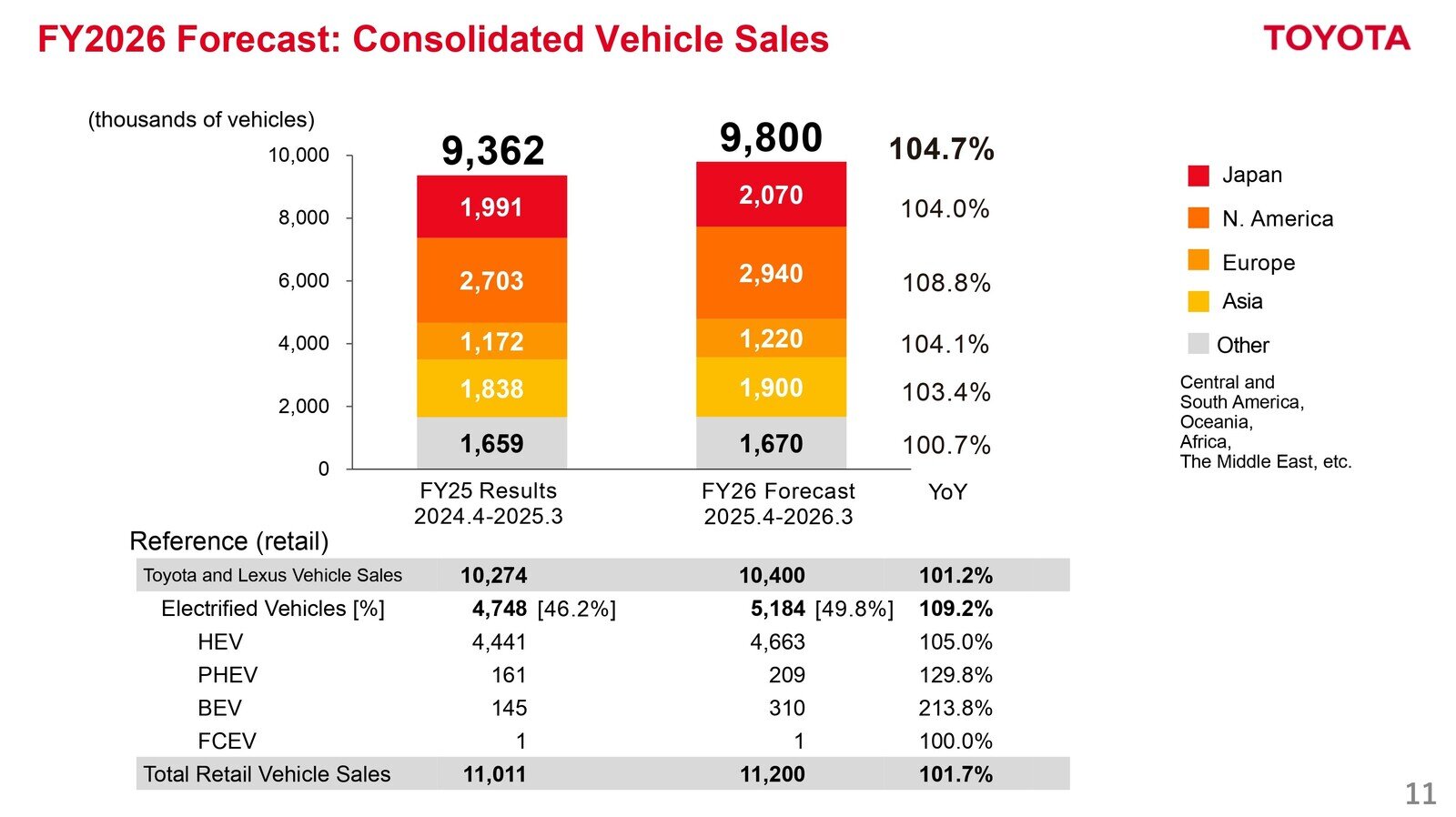
Despite facing U.S. tariffs, Toyota says it will not waver in sustaining domestic production at three million vehicles. How did the company's leaders respond to questions at the recent financial results briefing?

On May 8, Toyota presented its financial results for the year to March 2025.
Following Executive Vice President Yoichi Miyazaki’s explanation of the results and a speech by President Koji Sato, Toyota’s leaders answered questions from the media. Most often, these focused on the impact of the automotive tariffs imposed by the U.S. government last month.
Will Toyota move production bases to the United States? Will the company drop its commitment to producing three million vehicles in Japan?
The string of questions spoke to the uncertainty surrounding this economic policy, which dealt a major shock to the world.
In response, President Sato assured reporters that Toyota will not panic, while Vice President Miyazaki also vowed to avoid “knee-jerk reactions.”
With the future impossible to predict, how does Toyota view the situation, and what steps will it take to adapt? Here are the pair’s responses to the media’s questions.
Views on tariff policy
You explained that the estimated impact for April and May 2025 (180 billion yen) has been tentatively factored in, but if the tariff policy is prolonged, what additional effect do you anticipate on Toyota’s forecast for the year to March 2026?
President Sato
With regard to the U.S. tariffs, both governments are currently working hard to conclude negotiations. The fluid situation makes it difficult to foresee what lies ahead.
At the same time, we have included the tariffs already in effect within our forecast for this fiscal year.
The most important thing for us is to keep our feet firmly on the ground and continue doing what we can, without panicking or losing our focus.
The things we can do differ in the short- and medium- to long-term. Our export volume to the United States is approximately 500,000 vehicles. While it would be desirable to allocate this volume to the U.S., where we have many customers, in the short term, we will explore measures such as adjusting deliveries. In the longer term, we will look to develop and manufacture products locally, tailored to local customers.
As a corporate citizen, Toyota embraces a “best in town” philosophy, with corporate activities rooted in the areas where we do business. We remain committed to this approach and will continue to pursue initiatives with the same mindset.
How do you view the impact on business moving forward? You explained your response in the short- and medium- to long-term, but do you see the tariff policy as temporary, or a permanent change?
President Sato
To reiterate, at Toyota we strive to be a “best in town” company whose business is rooted in the local region. This core philosophy will not change, regardless of America’s tariff policies.
Therefore, as I outlined earlier, from the long-term perspective we are firmly pursuing local development and production. In the short term, we will refine our operations to ensure we can meet demand in the optimum way. We will respond to the tariffs through a combination of these efforts.
On the question of whether the current tariff policy will become permanent, that is not something we can determine. As such, the key for us lies in adapting flexibly without wavering from our core vision, to ensure that we can continue doing business regardless of how circumstances change.
No knee-jerk price rises
Do you plan to pass on the tariff burden through vehicle prices?
Vice President Miyazaki
We believe that prices are determined by customers. Looking at the competition and actual demand, we identify very strong customer demand and will adjust pricing accordingly at the right time.
In any case, we will not simply raise prices as a knee-jerk reaction to short-term tariffs. We will steadily take things as they come.
When pressed on Toyota’s stance towards suppliers—whether the company would revise the prices of purchased parts or try to compensate through cost-reduction measures—Vice President Miyazaki responded, “We will engage each company on an individual basis and carefully discuss the matter. We remain committed to working closely with the suppliers and dealers who are our carmaking partners, as well as for the happiness of our customers.”
North American sales volume forecast
What is your outlook for U.S. sales volumes within the profits you project? There are suggestions that the rush in demand (before tariffs take effect) will be followed by a downturn. What is your forecast at this point?
Vice President Miyazaki
Although our results are based on the fiscal year (April 2025 to March 2026), when formulating business and sales plans, we think in terms of the calendar year (January to December 2025).
Demand in the U.S. market has swelled through March and April, partly due to the pre-tariff rush, but at some point we expect this to reverse, and the overall volume will likely fall around the level of our initial forecast.
As pointed out, however, there is no telling what the future holds. We will therefore shape our response based on actual events on the ground.
Toyota vehicles enjoy great popularity in the United States, with inventories sitting at less than ten days, or five for our mainstay hybrids. We will continue making adjustments while monitoring actual demand.
For FY2026, you have forecast sales of 2.94 million vehicles in North America, up more than 200,000 from the past year’s results. What is the rationale behind this increase?
Vice President Miyazaki
During the past fiscal year (FY2025), our Indiana Plant in the U.S. was forced to shut down production for a prolonged period due to quality-related issues.
By contrast, this year will bring a return to full production. As such, we foresee an increase, including ramped-up production to fulfill back orders (orders awaiting delivery of cars that were out of stock).

With so many changes taking place, we cannot foresee everything, but at this point in time, this is the level we are working towards. Naturally, we will adjust accordingly if circumstances change.
Our duty is to carefully sell each and every vehicle and deliver them to our customers.
In doing so, we hope to reach the figures we have presented today. As always, we want to keep aiming higher if possible.
Following these questions about the impact of tariff policies on vehicle prices and business performance, the focus turned to Toyota’s three million-strong domestic production and the possibility of shifting manufacturing to the United States.
President Sato spoke of an unwavering commitment to domestic production and went on to explain the role played by Japan’s automotive industry.

